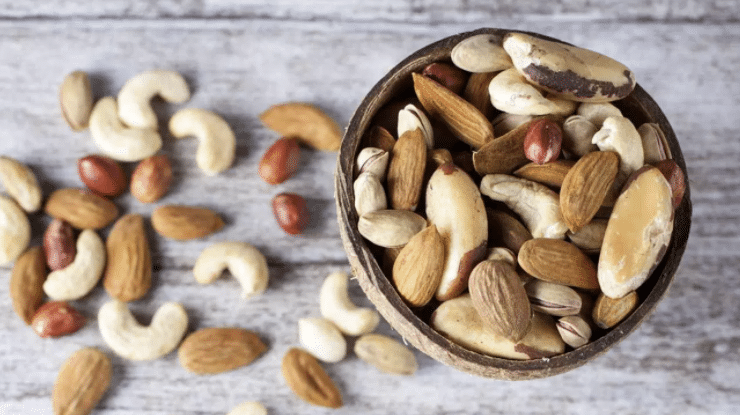- CALL US 877 221 NUTS (6887)
Raw vs Roasted Nuts: Which Is Healthier?

Nuts are extremely healthy and make a perfect snack when you’re on the go.
They are packed with healthy fats, fiber and protein, and they’re a great source of many important nutrients and antioxidants.
What’s more, studies have shown that eating nuts has several health benefits, including lowering cholesterol, blood pressure and blood sugar (1Trusted Source, 2Trusted Source, 3Trusted Source, 4Trusted Source).
However, some people wonder whether roasting nuts affects their nutritional content.
This article compares raw and roasted nuts and takes a detailed look at which variety is healthier.
Why Are Nuts Roasted?
Nuts are generally roasted to improve their taste, aroma and crunchy texture (5).
Roasting is defined as cooking using dry heat, which cooks the food evenly on all sides. Most nuts are roasted without their shell, except for pistachios, which are often roasted in-shell.
Meanwhile, raw nuts have not been roasted.
Roasting methods are sometimes used to separate the shells of nuts from their kernels. This is a common method of shelling cashews and the reason why they’re almost never sold raw (6Trusted Source).
There are two main kinds of roasting:
- Dry roasting: Roasting without any oil. Nuts can be dry roasted in the oven or on a frying pan.
- Oil roasting: Roasting using oil. Nuts can also be oil roasted in the oven or on a frying pan.
In addition to these two methods, nuts can be roasted in the microwave.
You can buy nuts roasted, or you can roast them yourself.
SUMMARY:Nuts are generally roasted to improve their texture and taste. They can be roasted with or without oil.
Both Have a Similar Nutrient Content
Roasting nuts changes their structure and chemical composition.
Specifically, it changes their color and decreases their moisture content, giving rise to their crunchy texture (5, 7).
Raw and dry-roasted nuts have very similar amounts of fat, carbs and protein. Although, roasted nuts have slightly more fat and calories per gram, but the difference is minimal.
One ounce (28 grams) of raw almonds contains 161 calories and 14 grams of fat, whereas the same amount of dry-roasted almonds contains 167 calories and 15 grams of fat (8, 9).
Similarly, 1 ounce (28 grams) of raw pecans contains 193 calories and 20 grams of fat, but the same amount of dry-roasted pecans contains 199 calories and 21 grams of fat (10, 11).
During roasting, nuts lose some moisture. Therefore, a roasted nut weighs less than a raw nut. That explains why the fat content per ounce is slightly higher in roasted nuts (12Trusted Source).
Some studies have shown that roasting nuts does not change the overall fat content. However, the polyunsaturated fats in roasted nuts become more susceptible to oxidation, as the structure of the nut changes (7, 13Trusted Source, 14Trusted Source).
Meanwhile, the protein and carb contents of raw and roasted nuts are very similar. Nevertheless, roasted nuts can be slightly higher or lower in these macronutrients, depending on the type of nut (15Trusted Source).
Contrary to what you might expect, oil-roasted nuts are only slightly higher in fat and calories than dry-roasted nuts. That’s because nuts are naturally high in fat and cannot absorb much more of it from added fat (16, 17).
SUMMARY:Raw, dry-roasted and oil-roasted nuts all contain very similar amounts of calories, fat, carbs and protein.
Roasting Might Damage the Healthy Fats in Nuts
Nuts are high in monounsaturated and polyunsaturated fats. These healthy fats have the ability to lower blood cholesterol and may protect against heart disease (18Trusted Source).
High Temperatures and Long Cooking Times Have the Greatest Impact
When polyunsaturated fats are exposed to heat, as is the case with roasting, they’re more likely to become damaged or oxidized.
This can lead to the formation of harmful free radicals, which can damage your cells.
Oxidized fat, or rancid fat, is responsible for the “off” taste and smell in some nuts.
Luckily, you can reduce the formation of these free radicals by controlling the roasting process.
The key is to regulate the cooking temperature and time. Studies have shown that when nuts are roasted at a low-to-medium temperature, their fats are less likely to go bad.
One study showed that the higher the roasting temperature and the longer the roasting time, the more likely the nuts were to contain a substance that indicated oxidation. The likelihood of oxidation also depended on the nut type (13Trusted Source).
For example, when walnuts were roasted under extreme conditions at 356°F (180°C) for 20 minutes, the substance that indicated oxidation increased by 17 times, compared to raw walnuts (13Trusted Source).
In comparison, the substance that indicated oxidation only increased by 1.8 times for hazelnuts and 2.5 times for pistachios (13Trusted Source).
This is explained by the high amount of polyunsaturated fat in walnuts. It accounts for 72% of their total fat content, which is the highest fat content of all nuts (19).
In the same study, when walnuts were roasted at a medium temperature (248–320°F or 120–160°C), the extent of oxidation was much lower (13Trusted Source).
Oxidation Can Occur During Storage
The polyunsaturated fat in nuts is also more vulnerable to oxidation during storage.
This is because the structure of nuts changes when they’re roasted, allowing fat to come into contact with oxygen more easily and thus become oxidized (7).
This reduces the shelf life of nuts. Thus, roasted nuts should be stored for shorter periods than raw nuts.
Furthermore, some studies indicate that trans fats are formed after roasting, but the amount is negligible (20Trusted Source, 21Trusted Source).
SUMMARY:Roasting might damage the healthy polyunsaturated fats in nuts, but you can help minimize this damage by roasting at a low temperature. Also, roasting nuts shortens their shelf life.
Some Nutrients Are Lost During Roasting
Nuts are a great source of nutrients, including vitamin E, magnesium and phosphorus. They’re also loaded with antioxidants.
Some of these nutrients are sensitive to heat and might be lost during the roasting process.
For example, some types of antioxidants are degraded during roasting. Antioxidants are important for your health because they help protect your cells against damage from free radicals (13Trusted Source).
Nevertheless, increased temperature and roasting time have been shown to decrease antioxidant activity, but only up to a certain point.
In one study, the levels of antioxidants in various nuts decreased constantly from the start of roasting at 302°F (150°C) until 30 minutes later (22).
Interestingly, the antioxidant activity increased after 60 minutes. This is because compounds that have antioxidant activity are formed in a chemical reaction when nuts are roasted (13Trusted Source, 22).
Furthermore, not all antioxidants are damaged by roasting. One study reported that the amounts of the antioxidants lutein and zeaxanthin in pistachios and hazelnuts were not affected by roasting (23Trusted Source).
Studies also indicate that vitamin E, thiamine and carotenoids are lost during roasting. However, the extent of the loss really depends on the nut type and roasting temperature (13Trusted Source, 21Trusted Source, 23Trusted Source).
In fact, one study showed that roasting almonds and walnuts caused a greater vitamin loss than roasting hazelnuts, while almost no vitamin loss occurred during the pistachio roasting process.
The extent to which vitamin loss occurred increased in line with increased roasting temperatures (23Trusted Source).
Levels of alpha-tocopherol, the most active form of vitamin E, also seem to be affected during roasting. After roasting for 25 minutes at 284°F (140°C), levels decreased by 20% in almonds and 16% in hazelnuts, compared to raw nuts (23Trusted Source).
The higher the roasting temperature, the more alpha-tocopherol was lost. After 15 minutes of roasting at 320–340°F (160–170°C), the levels were reduced by 54% in almonds and 20% in hazelnuts, compared to raw nuts (23Trusted Source).
Thiamine levels also decreased during roasting, and like alpha-tocopherol, they decreased more at higher temperatures. Riboflavin levels were not affected (23Trusted Source).
Overall, every type of nut and each nutrient responds differently to roasting, depending on the nut type and the roasting conditions.
Although some vitamins are lost during roasting, keep in mind that nuts are not the main sources of these vitamins. The exception to this is almonds, which are high in vitamin E (8).
SUMMARY:Some antioxidants and vitamins are lost during roasting. The extent of the loss depends on the roasting temperature and time. It also differs between nut type.
Roasting Nuts May Form Harmful Chemicals
The rich flavor, color and aroma of roasted nuts is due to compounds that are formed in a chemical reaction called the Maillard reaction.
This is a reaction between the amino acid asparagine and the natural sugar in the nuts. It happens when they’re heated above 248°F (120°C) and gives roasted nuts their brown color (24Trusted Source).
Acrylamide
The Maillard reaction may also be responsible for the formation of the harmful substance acrylamide.
This substance is known to cause cancer in animals when consumed in very high doses. It may have potential cancer-causing effects in humans, but the evidence is scarce (25Trusted Source, 26Trusted Source).
Roasting temperature has a greater impact on acrylamide formation than the duration of roasting (27Trusted Source).
Almonds are most susceptible to the formation of acrylamide, since they contain high amounts of the amino acid asparagine.
Acrylamide starts to form in almonds when they are heated above 266°F (130°C). The formation of acrylamide becomes especially high at temperatures above 295°F (146°C) (28Trusted Source, 29Trusted Source).
Results from one study showed that acrylamide levels increased significantly when almonds were roasted for 25 minutes at temperatures between 282–323°F (139–162°C) (13Trusted Source).
Different Nuts Produce Different Levels of Acrylamides When Roasted
The same study showed that other nuts had lower levels of acrylamide when they were roasted.
Levels of the compound nearly doubled in pistachios when they were roasted at the same temperature as almonds, and no acrylamide was detected in roasted macadamia nuts, walnuts or hazelnuts (13Trusted Source).
It’s important to note that even though you are exposed to acrylamide in almonds, as well as in other foods, these amounts are much lower than the amount considered to be harmful (26Trusted Source, 30).
However, if you want to minimize acrylamide exposure from almonds, make sure to roast them at a relatively low temperature of about 265°F (130°C).
SUMMARY:A harmful substance called acrylamide might form in almonds when they’re roasted at high temperatures. However, the amount of acrylamide this may produce is probably not harmful.
Raw Nuts Might Contain Harmful Bacteria and Fungi
Potentially harmful bacteria, such as Salmonella and E. coli, might be present in raw nuts.
That’s because nuts are sometimes thrown on or fall to the ground during harvesting. If the soil is contaminated with bacteria, the nuts will easily come into contact with the bacteria.
Contaminated water might also introduce harmful bacteria, either during harvest or post-harvesting.
In fact, Salmonella has been detected in raw nuts, including almonds, macadamia nuts, walnuts and pistachios (31Trusted Source, 32Trusted Source, 33Trusted Source).
One study reported that nearly 1% of samples of various nuts contained Salmonella, with the highest contamination rate in macadamia nuts and lowest in hazelnuts. It was not detected in pecans.
However, the amount of Salmonella detected was low, so it might not cause illness in healthy individuals (31Trusted Source).
Though outbreaks due to contaminated nuts are uncommon, they’re very serious.
In the US, consuming raw almonds has been linked to a Salmonella outbreak, while consuming in-shell hazelnuts has been associated with an outbreak of E. coli (34Trusted Source, 35Trusted Source).
In order to reduce Salmonella, all almonds in the US today are required to be pasteurized (36Trusted Source).
While roasting nuts reduces the number of bacteria on them, Salmonella was detected in one sample of roasted pistachios in one study. Another study found no Salmonella or E. coli in roasted nuts (37Trusted Source, 38Trusted Source).
Furthermore, nuts may contain the toxic carcinogen aflatoxin, which is produced by fungi that sometimes contaminate nuts and grains.It has been detected in both raw and roasted nuts, including pistachios and walnuts. Aflatoxin is very heat resistant and might survive the roasting process (39Trusted Source, 40Trusted Source).
The best way to avoid aflatoxin contamination is through control of humidity and temperature during drying and storage, rather than roasting (40Trusted Source).
SUMMARY:Raw nuts may contain harmful bacteria, such as Salmonella. Aflatoxin may also be present in nuts. Proper handling and storage is the best way to prevent contamination.
Which Type Should You Eat
The short answer is both.
Raw nuts are very healthy, but they might contain harmful bacteria. However, even if they do, it is unlikely to cause an illness.
Roasted nuts, on the other hand, may contain fewer antioxidants and vitamins. Some of their healthy fats may also become damaged and acrylamide might form, though not in harmful amounts.
In the end, roasting temperature and duration can have a big impact.
If nuts are roasted at a low-to-medium temperature of about 284°F (140°C) for approximately 15 minutes, vitamin loss is kept to a minimum, healthy fats are unharmed and acrylamide is less likely to form.
If you want to eat roasted nuts, keep in mind that some roasted nuts sold in stores are seasoned with salt, and some are even sugar-coated.
Instead of buying nuts roasted, buy them raw and roast them yourself, preferably in the oven. That way you can better control the temperature and roast larger quantities of nuts at a time.
What’s more, roasting at low temperatures between 248–284°F (120–140°C) — and even at middle temperatures between 284–320°F (140–160°C) — has been shown to create the most likable taste and texture (13Trusted Source).
If you want to enhance the flavor by oil roasting the nuts, keep in mind that some oils are not suitable for roasting. Oil roast them yourself and choose a heat-stable oil, such as coconut oil.
SUMMARY:Both raw and roasted nuts are healthy. It’s best to roast them yourself at a low-to-medium temperature of about 284°F (140°C) for roughly 15 minutes.
The Bottom Line
Both raw and roasted nuts are good for you and provide health benefits.
Both varieties contain similar amounts of calories, protein, carbs and fiber.
However, roasting nuts may damage their healthy fat, reduce their nutrient content and lead to the formation of a harmful substance called acrylamide.
On the other side, raw nuts are more likely than roasted nuts to contain harmful bacteria like Salmonella.
That said, these risks are low.
Importantly, how nuts are roasted can have a big impact on their nutrient content. If you roast them yourself, keep the temperature relatively low, at about 284°F (140°C) for 15 minutes. The nuts should come out with a lightly roasted color.
Also, make sure not to store them for too long, since they have a limited shelf life. Only roast nuts that you are planning to eat over the next few days.


 Free Shipping
Free Shipping

